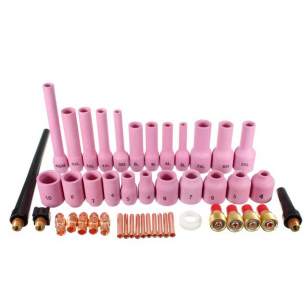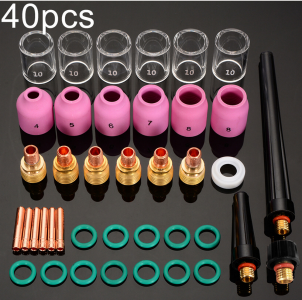- Joined
- May 27, 2016
- Messages
- 3,480
Still starting from ignorance, and looking at the stuff one can get in consumables kits. Please forgive how basic these questions are, but they happen when one is purchasing all the stuff to get enough TIG kit together for a weld to happen in the first place!
Cups diameter sizes at the exit seem to range from 4 to 10, this being a count of how many sixteenth inches, though I dare say it may not be all of them. Fairly obvious is that the little pink cups can be longer (L), or quite a lot longer (XL), though going longer seems to be something confined to the smaller sizes. Hence..

1. What are the motivations for these (small & long), other than to reach into a confined spaces?
Does it force a length of tungsten electrode become "wasted". Are all these really needed? Can one do nearly all with a size 7? Can you use any cup with any size electrode? What is the wisdom about choosing a electrode + cup size combination when considering a weld?
2. We then get a similar scene when the innards are changed to be "gas lenses" type. Various arrangements of trick grids and gauze and seals to persuade a longer column of non-turbulent gas flow. So the question. Does using gas lens remove the need for various lengths? We can see that there are sets of pink ceramic cups that go with gas lens. Are they different from regular ceramic cups? Is it a thing about size compatibility? I guess I am asking whether one has to take care not to get them mixed up with non gas lens types which also happen to be pink?

3. Next we see a series of clear pyrex cups. They obvious difference is that one can see through them. The presence of these seems to be associated with gas lens kits, so it begs the question. Are clear see-through pyrex cups used in regular TIG (ie. no gas lens).
4. Also seemingly associated with gas lens kits is "stubby". Other than that one chose a short cup, what is the deal with stubby? Is it something that always goes with gas lens?
Cups diameter sizes at the exit seem to range from 4 to 10, this being a count of how many sixteenth inches, though I dare say it may not be all of them. Fairly obvious is that the little pink cups can be longer (L), or quite a lot longer (XL), though going longer seems to be something confined to the smaller sizes. Hence..

1. What are the motivations for these (small & long), other than to reach into a confined spaces?
Does it force a length of tungsten electrode become "wasted". Are all these really needed? Can one do nearly all with a size 7? Can you use any cup with any size electrode? What is the wisdom about choosing a electrode + cup size combination when considering a weld?
2. We then get a similar scene when the innards are changed to be "gas lenses" type. Various arrangements of trick grids and gauze and seals to persuade a longer column of non-turbulent gas flow. So the question. Does using gas lens remove the need for various lengths? We can see that there are sets of pink ceramic cups that go with gas lens. Are they different from regular ceramic cups? Is it a thing about size compatibility? I guess I am asking whether one has to take care not to get them mixed up with non gas lens types which also happen to be pink?

3. Next we see a series of clear pyrex cups. They obvious difference is that one can see through them. The presence of these seems to be associated with gas lens kits, so it begs the question. Are clear see-through pyrex cups used in regular TIG (ie. no gas lens).
4. Also seemingly associated with gas lens kits is "stubby". Other than that one chose a short cup, what is the deal with stubby? Is it something that always goes with gas lens?

